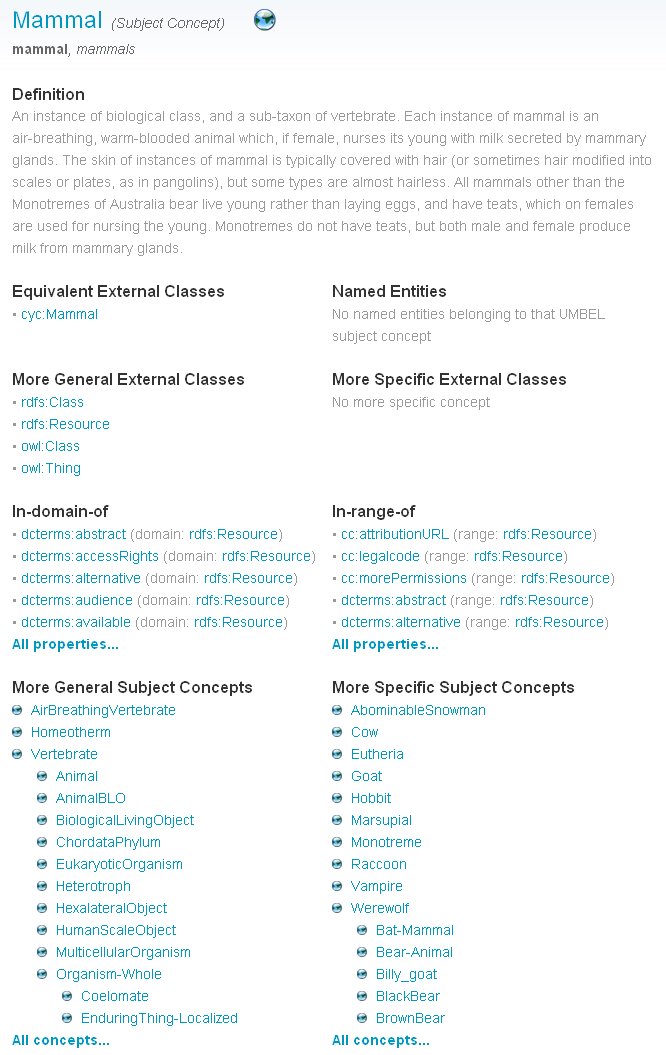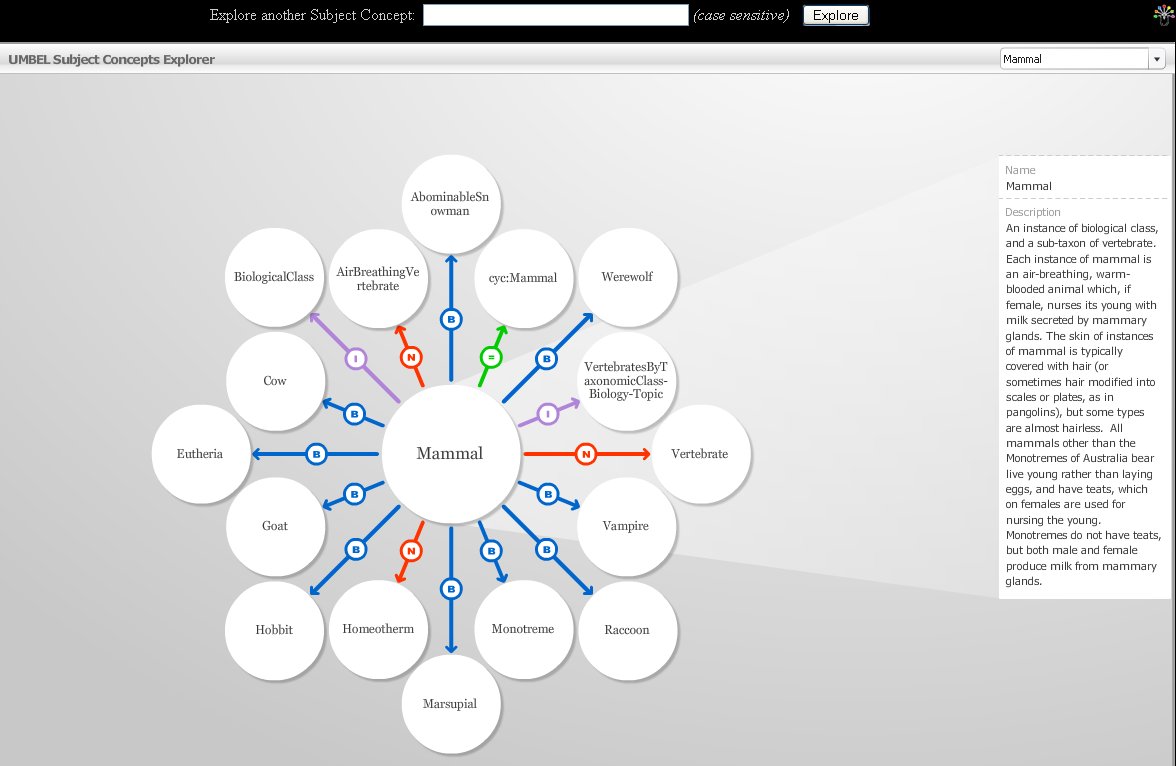There’s Some Cool Tools in this Box of Crackerjacks
UMBEL is today releasing a new sandbox for its first iteration of Web services. The site is being hosted by Zitgist. All are welcomed to visit and play.
And, UMBEL is What, Again?
UMBEL (Upper-level Mapping and Binding Exchange Layer) is a lightweight reference structure for placing Web content and data in context with other data. It is comprised of about 21,000 subject concepts and their relationships — with one another and with external vocabularies and named entities.
Each UMBEL subject concept represents a defined reference point for asserting what a given chunk of content is about. These fixed hubs enable similar content to be aggregated and then placed into context with other content. These subject context hubs also provide the aggregation points for tying in their class members, the named entities which are the people, places, events, and other specific things of the world.
The backbone to UMBEL is the relationships amongst these subject concepts. It is this backbone that provides the contextual graph for inter-relating content. UMBEL’s subject concepts and their relationships are derived from the OpenCyc version of the Cyc knowledge base.
The UMBEL ontology is based on RDF and written in the RDF Schema vocabulary of SKOS (Simple Knowledge Organization System) with some OWL Full constructs to aid interoperability.
UMBEL’s backbone is also a reference structure for more specific domains or ontologies, thereby enabling further context for inter-relating additional content. Much of the sandbox shows these external relationships.
UMBEL’s Eleven
These first set of Web services provide online demo sandboxes, and descriptions of what they are about and their API documentation. The first 11 services are:
- Find Subject Concepts — look up via name, URI or alias one of the 21,000 UMBEL subject concepts
- Subject Concept Report — basic information about the subject concept; description, canonical name, and the like
- Subject Concept Detailed Report — very cool! see below
- List Sub-Concepts & Sub-Classes — for developers and ontology geeks
- List Super-Concepts & Super-Classes — for developers and ontology geeks
- List Equivalent External Classes — for developers and ontology geeks
- Verify Sub-Class Relationship — for developers and ontology geeks
- Verify Super-Class Relationship — for developers and ontology geeks
- Verify Equivalent Class Relationship — for developers and ontology geeks
- Subject Concepts Explorer — good golly, Miss Molly, we have visuals!
- Yago Ontology — a little help from our friends.
A CLASSy Detailed Report
The single service that provides the best insight to what UMBEL is all about is the Subject Concept Detailed Report. (That is probably because this service is itself an amalgam of some of the others.)
Starting from a single concept amongst the 21,000, in this case ‘Mammal’, we can get descriptions or definitions (the proper basis for making semantic relationships, not the ‘Mammal’ label), aliases and semsets, equivalent classes (in OWL terms), named entities (for leaf concepts), more general or specific external classes, and domain and range relationships with other ontologies. Here is the sample report for ‘Mammal’:
The discerning eye likely observes that while there are a rich set of relationships to the internal UMBEL subject concepts, coverage is still light for external classes and named entities. This sandbox is, after all, a first release and we are early in the mapping process. 🙂
But, it should also start to become clear that the ability of this structure to map and tie in all forms of external concepts and class structures is phenomenal. Once such class relationships are mapped (to date, most other Linked Data only occurs at the instance level), all external relationships and properties can be inherited as well. And, vice versa.
So, for aficionados of the network effect, stand back! You ain’t seen nothing yet. If we have seen amazing emergent properties arising from the people and documents on the Web, with data we move to another quantum level, like moving from organisms to cells. The leverage of such concept and class structures to provide coherence to atomic data is literally primed to explode.
Bloomin’ Concepts!
To put it mildly, trying to get one’s mind around the idea of 21,000 concepts and all of their relationships and all of their possible tie in points and mappings to still further ontologies and all of their interactions with named entities and all of their various levels of aggregation or abstraction and all of their possible translations into other languages or all of their contextual descriptions or all of their aliases or synonyms or all of their clusterings or all of their spatial relationships or all of the still more detailed relationships and instances in specific domains or, well, whew! You get the idea.
It is all pretty complex and hard to grasp.
One great way to wrap one’s mind around such scope is through interactive visualization. The first UMBEL service to provide this type of view is the Subject Concept Explorer, a screenshot of which is shown here:
But really, to gain the true feel, go to the service and explore for yourself. It feels like snorkeling through those schools of billions of tiny silver fish. Very cool!
These amazing visualizations are being brought to us by Moritz Stefaner, imho one of the best visualization and Flash gurus around. We will be showcasing more about Moritz’s unbelievable work in some forthcoming posts, where some even cooler goodies will be on display. His work is also on display at a couple of other sites that you can spend hours drooling over. Thanks, Moritz!
Missing Endpoints and Next Steps
You should note that developer access to the actual endpoints and external exposure of the subject concepts as Linked Data are not yet available. The endpoints, Linked Data and further technical documentation will be forthcoming shortly.
The currently displayed services and demos provided on this UMBEL Web services site are a sandbox for where the project is going. Next releases will soon provide as open source under attribution license:
- The formal UMBEL ontology written in OWL Full and SKOS
- Technical documentation for the ontology and its use and extension
- Freely accessible Web services according to the documentation already provided
- Technical documentation and reports for the derivation of the subject concepts from OpenCyc and the creation and extension of semsets and named entities related to that structure.
When we hit full stride, we expect to be releasing still further new Web services on a frequent basis.
BTW, for more technical details on this current release, see Fred Giasson’s accompanying post. Fred is the magician who has brought much of this forward.









One thought on “Announcing the UMBEL Web Services Sandbox”